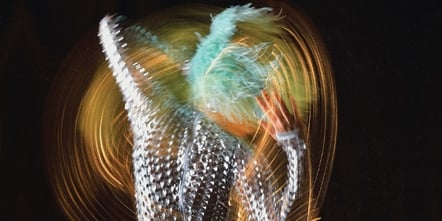New York, NY (Top40 Charts) Debuting the intriguingly configured ensemble Chroma Nova (new color), acclaimed tenor and soprano saxophonist Michael
Blake is excited to share with the world Dance of the Mystic Bliss: a batch of vibrant original pieces, performed by an eclectic and highly credentialed unit of four string players (guitar, violin, cello, bass) and two Brazilian multi-percussionists.
Dance of the Mystic Bliss also marks Blake's recording debut (as a leader) on flute, an instrument he spent time woodshedding during lockdown. In a 25-year career spanning 15 albums, not to mention innovative stints with the Lounge Lizards, the Jazz Composers
Collective and much more, the 58-year-old
Blake is reaching for new sounds, new skills and the widening of his artistic world.
Dance of the Mystic Bliss follows Blake's well-received brass band outing Combobulate (Newvelle, 2022) with a different sound altogether. The groove is deep, yet
Blake did not set out with the literal notion of a "Brazilian jazz" album: it's the special synergy between these instrument groupings, and what it does for the melodic, rhythmic and textural depth of Blake's writing, that set the direction. Incisive mixing by genre-hopping veteran
Scotty Hard, a collaborator of Blake's since his 1997 debut Kingdom of Champa, brings it all to life.
The album finds a natural home on P&M Records, the label recently founded by
Blake and his London-based brother Paul. It's fitting that Dance of the Mystic Bliss would involve family, as the album's emotional climate is shaped by the death at 81 of the
Blake siblings' mother, Merle.
She is "Merle the Pearl," namesake of the leadoff track, an inspired reworking of a piece that
Blake first documented with a jazz quartet lineup on Elevated (2002). Merle was an avid gardener, and the song titles on Dance of the Mystic Bliss - "Le Coeur du Jardin," "Weeds," "Prune Pluck Pangloss," "Cleopatra," "The Meadows" - are meant to keep that part of her alive.
"The Meadows," a ravishing flute feature, revamps the sonic palette of a piece from 2006's More Like Us (by Blake's Danish group
Blake Tartare). "Prune Pluck Pangloss," a reference to the character in Voltaire's Candide, finds
Blake switching from flute to tenor and back again.
The tenor solo is a moment
Blake vividly recalls in the studio, when inspiration struck and he and the band took flight. The "pruning" and "plucking" might evoke the sound of pizzicato strings, but it's also a nod to Candide's famous ending line "Il faut cultiver notre Jardin" ("we must cultivate our garden").
The dual percussionists on Dance of the Mystic Bliss are Rogerio Boccato (Brian Blade's Lifecycles, John Patitucci Trio), who plays a sit-down kit of cajón, pandeiro and other instruments, and Mauro Refosco (David Byrne, Brian Eno), using assorted hand drums including the full-bodied zabumba bass drum. Refosco contributes berimbau and marimba as well, adding harmonic weight and sometimes doubling melodies.
These elements enable Chroma Nova to lock in with bassist Michael Bates for a traditional forro feel on a piece like "Sagra," or mesh with Skye Steele's violin,
Christopher Hoffman's cello and Guilherme Monteiro's guitar to create a truly "new color," falling somewhere between traditions and continents.
























